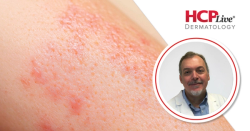
OR WAIT null SECS
Lifitegrast Sustains Rapid Effect for Dry Eye in Real-World Assessment
Lifitegrast shows rapid and sustained relief for dry eye disease, with high satisfaction among providers and patients, according to recent findings.
A quantitative and qualitative assessment of real-world utilization data reported the rapid and sustained response of lifitegrast ophthalmic solution 5% (Xiidra) for individuals with dry eye disease (DED).1
Presented at the 2025 American Society of Cataract and Refractive Surgery (ASCRS) Annual Meeting, nearly two-thirds of eye care providers reported near or complete symptom resolution in approximately 1300 patients with DED after 1-3 months of lifitegrast treatment.
“Quantitative survey and qualitative case data highlight the rapid and durable response associated with lifitegrast for the treatment of patients with DED,” wrote the investigator team, led by Francis S. Mah, MD, director of cornea and external disease and the co-director of refractive surgery at Scripps Clinic Medical Group. “Lifitegrast is used frequently in the management of DED in contact lens wearers and in patients undergoing various ocular surgeries.”
The US Food and Drug Administration (FDA) awarded approval to Bausch & Lomb’s lifitegrast ophthalmic solution 5% in July 2016 for the treatment of signs and symptoms of DED. A favorable safety profile was reported in five randomized, placebo-controlled trials ranging from 12 weeks to 1 year.2
In this study, Mah and colleagues explored the real-world utilization and outcomes of lifitegrast ophthalmic solution for patients with DED, using analyses of a provider survey (quantitative) and case studies (qualitative). A total of 12 eyecare providers, including 6 ophthalmologists and 6 optometrists, treating patients with DED, were invited to complete the survey.1
The survey comprised items on timing and degree of symptom resolution with lifitegrast, satisfaction with the onset of action, and the effectiveness of lifitegrast in treating DED (scale, 0 [very dissatisfied] to 10 [very satisfied]). Investigators measured the use of lifitegrast in DED combined with other ocular conditions, including contact lens wear, refractive, cataract, and vitreoretinal surgery, and keratoplasty.
Case study data on up to five patients who initiated lifitegrast were provided by eyecare providers. Overall, 12 eyecare providers treated an average of 1288 patients with DED annually, with approximately 21% of patients receiving lifitegrast. Among the providers, 7 provided 36 case reports, with an average age of 51 years.
Upon analysis, nearly all (92%) eyecare providers reported treating contact lens-induced DED with lifitegrast, with predominant uses including before or after refractive or cataract surgery (83% each). Approximately 67% of providers reported near or complete symptom resolution after 1 to 3 months of lifitegrast treatment.
Further analysis found the average satisfaction ratings for onset and effectiveness of lifitegrast were 6.8 and 6.6, respectively. Sustained improvement was identified during treatment up to 12 months, which investigators confirmed was supported by case data (mean, 15 months).
Safety analysis showed more than half (58%) of eyecare providers reported ≥1 patient experienced an adverse event during lifitegrast treatment. Adverse events deemed to be related to lifitegrast included blurred vision, burning/stinging, and dysgeusia, but all were considered mild or moderate in severity.
With an average number of 5 follow-up visits since initiating lifitegrast treatment, care report data suggested a sustained improvement during the treatment period, with a mean duration of 29 months.
References
Mah FS, Starr CE, Chan CC, et al. Quantitative and Qualitative Assessment of Real-World Lifitegrast Usage in Patients with Dry Eye Disease. Poster presented at the 2025 American Society of Cataract and Refractive Surgery (ASCRS) Annual Meeting. April 25-28, 2025. Los Angeles, CA.
Commissioner of the. FDA approves new medication for dry eye disease. U.S. Food and Drug Administration. July 12, 2016. Accessed April 27, 2025. https://www.fda.gov/news-events/press-announcements/fda-approves-new-medication-dry-eye-disease#:~:text=The%20U.S.%20Food%20and%20Drug,Monday%2C%20July%2011%2C%202016.
Related Content:


